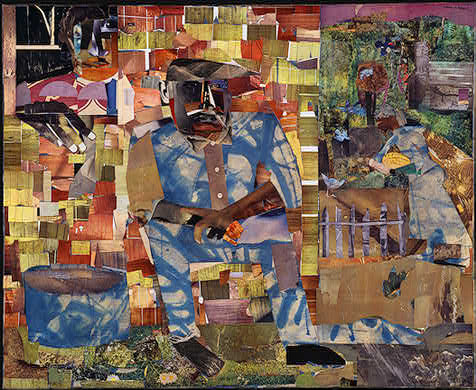Romare Bearden Gallery
collage of various papers with [charcoal and] graphite on canvas, 116.84 x 142.24 cm
From the Tour: Selected African American Artists at the National Gallery of Art
Born in Charlotte, North Carolina, seat of Mecklenburg County, on September 2, 1911, Romare Bearden grew up in a middle-class, African American family. Both parents Bessye and Howard were college-educated, and it was expected that Romare would achieve success in life. About 1914, his family joined the Great Migration of southern blacks to points north and west. Although slavery had been abolished during the early part of the 20th century, Jim Crow laws kept many blacks from voting and from equal access to jobs, education, health care, business, land, and more. Like many southern black families, the Beardens settled in Harlem section of New York City. Romare would call New York home base for the rest of his life.
Throughout his childhood, Bearden spent time away from Harlem, staying with relatives in Mecklenburg County, Pittsburgh, Pennsylvania, and Lutherville, Maryland. Bearden's memory of these experiences, as well as African American cultural history, would become the subjects of many of his works. Trains, roosters, cats, landscapes, barns, and shingled shacks reflected the rural landscape of his early childhood and summer vacations. Scenes of his grandparents' boardinghouse, bellowing steel mills, and African American millworkers recalled his Pittsburgh memories.
Bearden's first collages were composed primarily of magazine and newspaper cuttings. However, in style and technique his work was never static--it was always evolving. A turning point in Bearden's career was his creation of Projections, enlarged photostatic copies of smaller collages. Praised by critics, these unique, black-and-white images from 1964 combine collage and photo-reproductive techniques.
In Tomorrow I May Be Far Away, Bearden reflects on his childhood memories of Mecklenburg County. There is a focus or elevation of the everyday that becomes a frequent motif in both his North Carolina and Harlem imagery. Bearden employed a variety of media to create this collage, including cuttings from magazines, sample catalogs, wallpaper, art reproductions, and painted papers. Parts of the surface have also been reworked with spray paint and charcoal or graphite. Over the next thirty years, Bearden's collages would continue to evolve, employing flat areas of color defined by cut papers as wells as more patterned or textured areas created by cuttings of preprinted images, hand-painted papers, foils, and fabrics. Surface manipulation was also an ongoing concern for the artist, who explored news ways to rework the surface, including the use of bleach or peroxide, sandpaper, and perhaps even an electric eraser.
Although Bearden is best-known for his work in collage he achieved success in a staggering array of media, including watercolor, gouache, oil, painting, drawing, monotype, edition prints, photography, designs for record albums, costumes and stage sets, book illustration, and one known wood sculpture.

viewer |
|
|
| Odysseus |
| Prevalence of Ritual Mysteries |
| Family |
| Musicians |
| Block |
| Golgotha |
Tomorrow |
Biography
Bulletin Board
Renowned Art
(home)
Romare Bearden was born in Charlotte, North Carolina in 1914. His family soon moved to Harlem where he founded the "306 Group", a club for Harlem's artists. During the 1940's, his style combined African culture and symbols with a stylized realism. After a stay in Paris, Bearden's work became more abstract, using layers of oil paint to produce muted, hidden effects. During the 1960's civil rights movement, his focus shifted again, to collage, considered his best work
all artists, with thumbnails: by birth year | alphabetically
all artists: by birth year | alphabetically
artists born in the 13th 14th 15th 16th 17th 18th 19th 20th century